New York City Ballet’s Spring Gala celebrates with new ballets and a recent masterwork.
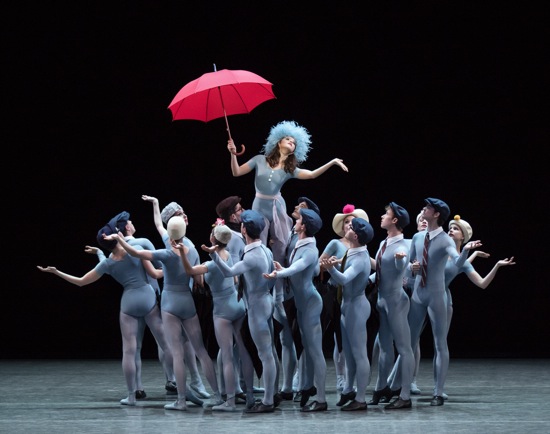
Indiana Woodward shelters the crowd in an excerpt from Jerome Robbins’ The Concert, or, The Perils of Everybody. Photo: Paul Kolnik
Fundraising galas are strange beasts. The New York City Ballet’s May event was no exception. Women swan by in improbable gowns, assuming no one would dare to step on their trains; some display—intricately—enough skin to make you wonder how the garment is anchored. Festive roped-off tables and a similarly barricaded cocktail area eat up the second floor lobby of the company’s Lincoln Center home. Less affluent attendees lurk in the remaining narrow space.
Galas are a necessary part of big companies’ lives. We bear them and enjoy them for the artistic progress that they enable. This particular NYCB event honored Jay Fishman. the chairman of the company’s board, and a film praising his leadership and patronage made it clear that he is loved by all who have worked with him. He was more slyly lauded by the evening’s opener, Rain, an excerpt from Jerome Robbins’s brilliant comedy ballet The Concert (1956). While pianist Elaine Chelton played Chopin’s “Raindrop Prelude,” the dancers opening and closing their umbrellas performed this humorous, yet very moving vision of crowd behavior in the appropriate manner, but Robbins’s ghostly face, purple with rage, might well have loomed over Ballet Master in Chief Peter Martins as he was altering the ending to suit this occasion. In the full ballet, it’s a nice joke when the charmingly eccentric lady in the big hat (originally Tanaquil LeClercq) appears as if by magic, lifted high from among the crowd in a scene from which she has hitherto been absent. This time, a newcomer (Indiana Woodward) hoists a red umbrella, rather than one of the ubiquitous black ones. Why? Until last year, Fishman was CEO of The Travelers Companies, whose identifying symbol is a red umbrella.
Christopher Wheeldon is seen in another film, talking thoughtfully about his ballet, American Rhapsody, on this occasion of its premiere, as well as rehearsing it with the company of which he was a member for seven years and for which he has already created nineteen ballets—all excellent, some of them marvels. He has in addition choreographed works for numerous other companies, ventured into opera and film, and, recently into the Broadway stage (he is the director and choreographer of the much-praised, award-winning production of An American in Paris, currently running at the Palace Theater).
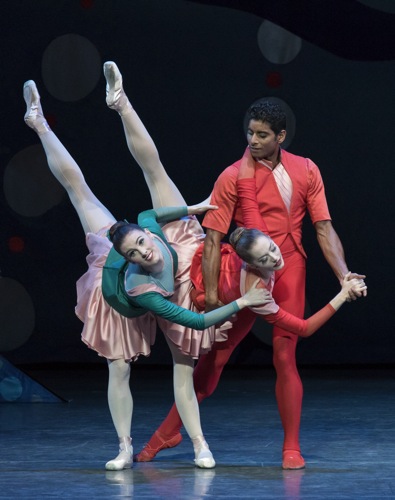
Amar Ramasar assists Tiler Peck (L) and Unity Phelan in Christopher Wheeldon’s American Rhapsody. Photo: Paul Kolnik
I seem to recall that Wheeldon grew up in England loving musicals, and in 2003 he created a sweet little ballet based on Rodgers and Hammerstein’s Carousel for NYCB. Evidently crafting An American in Paris left him with a yen to choreograph to more Gershwin music. His choice: the symphonic version of the composer’s 1924 Rhapsody in Blue, written when the composer was only as old as the century. At the gala, the entire NYCB orchestra rose from the pit via elevator so that Wheeldon and guest conductor Rob Fisher (who adapted and arranged the An American in Paris score) could talk jokingly and with expertise about the music—both its dreamily bluesy moments and its impetuous, rollicking ones—asking the musicians to demonstrate certain passages before sinking back into the pit.
Rhapsody in Blue doesn’t rank among Wheeldon’s greatest ballets, but it’s musically apt, smartly constructed, and enjoyable. An ensemble of eight men and eight women congregates and disperses attractively around two principal couples: Tiler Peck and Robert Fairchild (the latter returns to NYCB after sloughing off his stint in the Gene Kelly role in An American in Paris) and Unity Phelan with Amar Ramasar. Phelan is a member of NYCB’s corps de ballet; she dances Wheeldon’s choreography with winning precision, modest charm, and the authority of a ballerina.
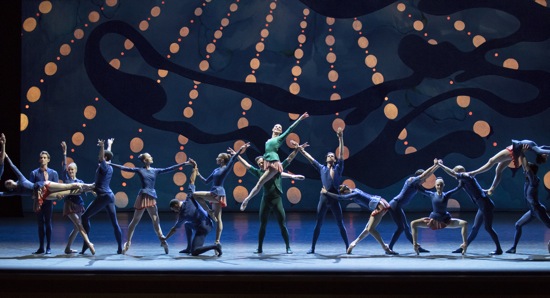
Tiler Peck and Robert Fairchild (center) in the final tableau of Christopher Wheeldon’s American Rhapsody. Photo: Paul Kolnik
Fairchild juts out a mean hip when jazziness begins to tinge the music more boldly, and when Peck soloes, she proves that she’s a match for him (they know the same quirky steps—in ballet, that’s a good reason for falling in love). He also, at some point, mimes temporary depression with several sobbing contractions of his body that fall exactly on notes in the score. Some time after Fairchild meets Peck, this bewitching lady introduces herself into a duet that Ramasar and Phelan are negotiating, assisting Ramasar by hoisting his girlfriend’s leg while he turns her. The two men dance in comradely unison, backed by the male ensemble. Wheeldon, as always, deploys his dancers skillfully and with a fine sense of the music. In the end, all of them form a chain across the front of the stage, positioning themselves differently, as if they were trying to spell out a message to us. I doubt that Wheeldon aimed to foreground Gershwin by doing this, but the composer was one of the heroes of the evening, and Cameron Grant made the piano part ripple and sing eloquently.
The most effective among the costumes designed by former NYCB principal dancer Janie Taylor are those for the women of the ensemble: unevenly hemmed blue tunics hug their torsos above little pink skirts, whose gathers, when seen from a distance, suggest the red and white stripes of the American flag. The beads, bubbles, and ripples of Leslie Sardinias’s backdrop contribute to the celebratory, after-dark mood, and Mark Stanley provides his always enhancing lighting.
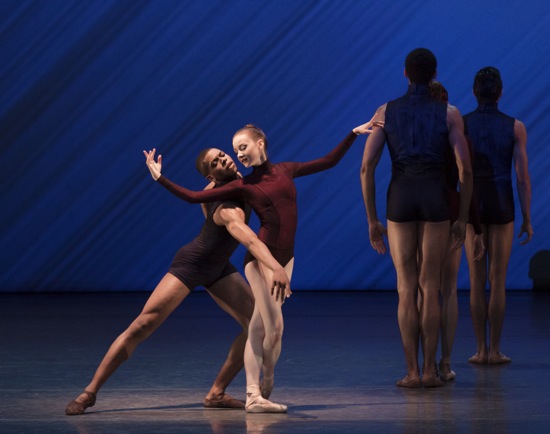
Christopher Grant and Alston Macgill in Nicolas Blanc’s Mothership. Photo: Paul Kolnik
The gala evening offered another premiere: Mothership by Nicolas Blanc, set to Mason Baker’s score of the same name for orchestra and electronica. Blanc developed his ballet last autumn for NYCB’s affiliate, the New York Choreographic Institute, which explains why three of its eight gifted dancers are company apprentices, while the remaining five are members of the corps de ballet.
Mothership the ballet is not as changeable or nervy as the young composer’s music, but Blanc, a ballet master for the Joffrey Ballet, manages his bright young cast with aplomb and knows how to make the space grow and shrink in interesting ways. Intriguing, too, is his opening, when one man picks up the solitary woman who’s standing with her back to us and deposits her among the waiting clan in the far left corner. Eventually everyone gets a partner, certain pairs have their time in the spotlight, and the ballet comes across as an exemplary model of what you’d hope for from a choreographer just hitting his stride.
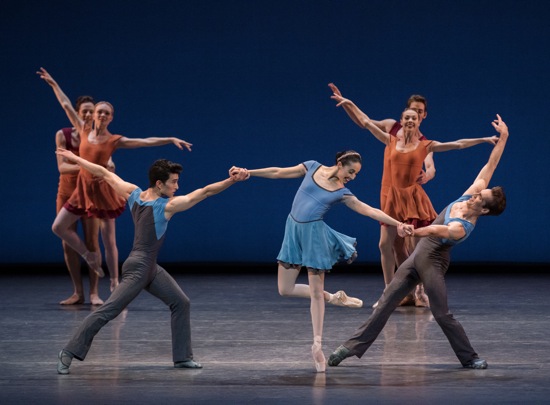
Alexei Ratmansky’s Concerto DSCH. (L to R, foreground): Anthony Huxley, Brittany Pollack, and Gonzalo Garcia. Photo: Paul Kolnik
Rain acted as a prelude to one of the most splendid ballets in the NYCB’s repertory: Alexei Ratmansky’s Concerto DSCH. When I first saw it at its 2008 premiere, I wrote that I instantly wanted to see it all over again. It was that fascinating, that heart-awakening. Being able to watch it on this program made the evening a gala one indeed.
Ratmansky choreographed the ballet to music by a fellow Russian: Piano Concerto No. 2 in F major, Op. 102 by Dmitri Shostakovich. The composer wrote the work in 1957 as a gift to his pianist son on the latter’s 19th birthday, so storminess is minimal. Concerto DSCH teems with life. I marvel how Ratmansky, using classical steps (including attention-getting devices such as women lifted high overhead) and phrasing them sensitively manages also to suggest a living-breathing community. Watching the ballet this time, I note the way he uses the circle (a great equalizer). Brittany Pollack (replacing Ana Sophia Scheller and doing so with verve) bursts from the opening cluster. Dancers circle to enclose Sara Mearns and Tyler Angle, as well as later suggesting a celebratory folk dance or a children’s ring-around-a-rosy. At one point, two outstanding men, Gonzalo Garcia and Anthony Huxley, circle a circling circle.
In the second movement adagio, the mood alters. A woman falls and is helped by others (not an action that takes more than a few seconds), who also seem despondent. Angle briefly drops his head into Mearns’s waiting hand; when in the ensuing pas de deux, he lifts her (both of them wonderful in these roles) and turns with her, she cradles his head in one curving arm (here the piano, played by Susan Walters, comes into sweet prominence). When Mearns bourrées away, Angle skids to her on his knees: don’t go! Six dancers surround the two and then unreel into couples. Mearns leaves, and Angle is alone and disconsolate again. The six form a chain across the front of the stage and pose in a formal way, yet as they break from that moment to go their separate ways, the man and the woman at one end of the line exchange a quick kiss. In little touches like this, Ratmansky humanizes and particularizes his performers and the atmosphere becomes more fragrant.
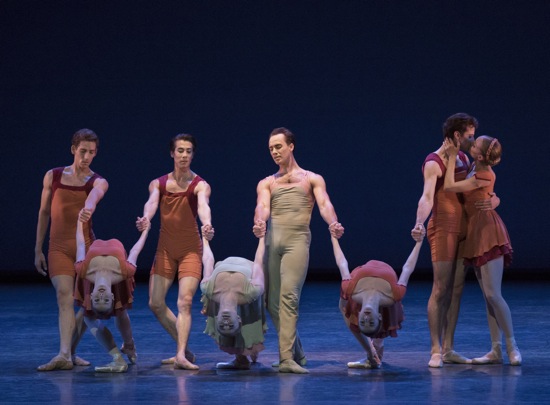
(L to R): New York City Ballet dancers in Alexei Ratmansky’s Concerto DSCH. (L to R): Cameron Dieck, Emilie Gerrity, Daniel Applebaum, Sara Mearns, Tyler Angle, Gretchen Smith, Andrew Scordato, and Lydia Wellington.
Photo: Paul Kolnik
Something in the musical air and the occasion for which it was composed affects the atmosphere of this ballet, yet you don’t think that there’s a plot that you should be understanding; you just sense a family event and remember that sadness often happens in the midst of joy. And the first and last sections are buoyantly joyful. Men jump straight up like fired-off rockets. In addition to the six dancers mentioned, there are four additional couples, which means more small groups to convene or dash apart to seek others. Pollack, Garcia, and Huxley (who excels in a solo) thread through the ballet, playing games and having a fine time whenever they meet. No one is left out.
The word “gala” has several nuanced meanings. One is “celebration.” This NYCB evening doesn’t just honor its supporters, it celebrates the company and ballets like this that reveal them so beautifully.

It was pleasing to read about everything here. Often i get baffled to see how subtle they are when performing. Also, the amount of efforts they put in to reach that level, amazing. Thanks for sharing this post.
Though married to the dance for 42 years, I dread the ‘gala’ for three reasons. First: the poor ushers are thwarted from their task because the ‘swells’ did not come to see but be seen. Second: the dancers, whose intricate preparations are delayed another fifteen minutes because the bus from West Eastville has not yet arrived. And third, me, who will have to race across a crowded lobby to join my fellow middle-aged, and older gentlemen, in a moment of relief, only to risk ‘de-training’ some lovely whose gown extends five feet beyond her derriere.
Galas are not for simple dance spouses. Especially when the available floor space is enveloped by yards of fabric.